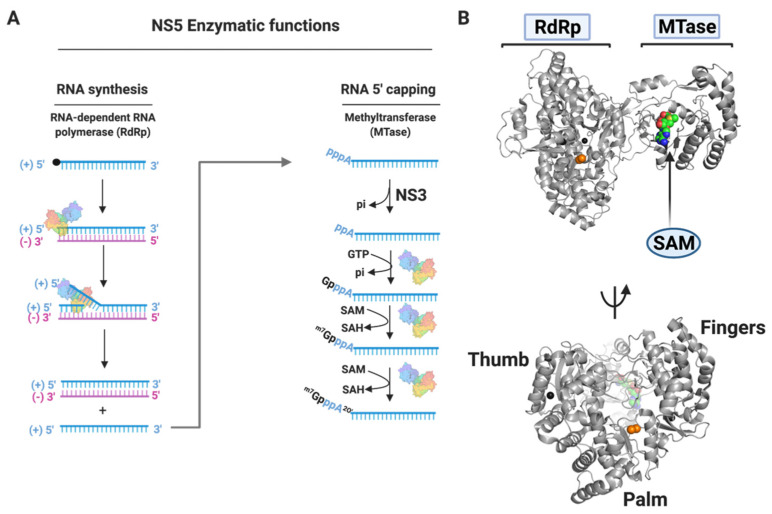Figure 3.
The Enzymatic Functions of Dengue NS5. NS5 plays a major role in the flaviviral replication complex including RNA synthesis, RNA capping, and RNA methylation. The exact sequence of events is not yet fully understood, but a general scheme (A) is widely accepted. The (+) strand genomic RNA is used by the NS5 RdRp as a template to synthesize a (−) strand RNA which results in a replicative dsRNA intermediate. The (−) strand of the dsRNA intermediate then serves as a template for (+) strand synthesis, after which the dsRNA product is released and used for additional synthesis of (+) strands. Newly synthesized (+) strands are capped and methylated to form (+) strands of genomic RNA. The 5′-RNA capping begins with the triphosphatase activity of the NS3 helicase, where the terminal phosphate at the 5′-end of the (+) strand RNA is removed leading to a diphosphorylated RNA. The NS5 methyltransferase (MTase) caps the RNA through its guanylyl-transferase activity, where guanine monophosphate (GMP) is transferred to the 5′-end of the diphosphorylated (+) strand RNA from GTP. The capped RNA is methylated by the NS5 MTase via two sequential methylations: an initial methylation at the N7 position of the guanine cap, and a subsequent methylation at the 2′O position of the first RNA nucleotide. S-adenosyl-L-methionine (SAM) is utilized as a methyl donor in both methylations and is converted to S-adenosyl-L-homocysteine (SAH) as a by-product of the reactions. A cartoon representation (B) of a crystal structure of the full-length dengue serotype 2 NS5 is shown with the canonical features of the NS5 RdRp. PDB ID: 5ZQK.

